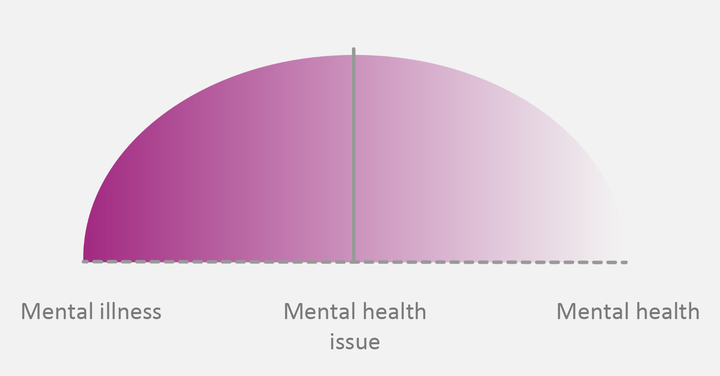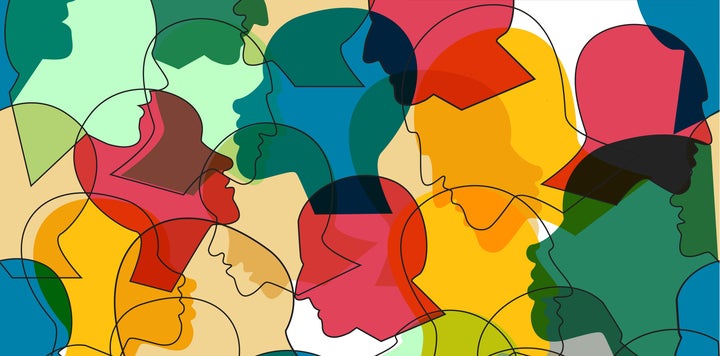We all have mental health, yet it can often be conflated with mental illness and the two are very different, not least because mental illness – which affects one in four people in their lifetime – can be utterly debilitating.
Getting the language right is a crucial step to reducing stigma and supporting each other, says Alison Pay, managing director of Mental Health At Work (MHAW), which runs customised programmes around workplace mental health.
“Many people, particularly in the workplace, find it difficult to use the term mental health, partly because of the fear and confusion around the word, with people often using it to mean mental illness,” she says.
“If we can understand the difference between mental health, mental illness and the gap in between, we can start to remove the stigma around the language, which is the first step in opening and normalising conversations.”
What Is Mental Health?
Mental health, understood simply, is a measure of our state of mind, just as physical health is a measure of our physical self. It can fluctuate day to day – or even hour by hour – and is influenced by many things in our lives, personal or professional, says Aimee Gee, head of news at Mind. There’s lots of terminology used to describe mental health, which can cause confusion – some people refer to it as ‘emotional health’ while others might call it ‘wellbeing’.
But in very simple terms, it may be helpful to think of mental health as existing on a continuum. It can vary depending on lifestyle factors such as how much sleep we’re getting, how stressful work is, whether we’re exercising and what our diet is like, explains MHAW’s senior facilitator Maggi Rose. It can also fluctuate whether or not you have a diagnosis of a mental illness.
Rose describes an invisible arrow on the diagram below. When we’re at our happiest or most content, our arrow is on the right-hand side – however if events in our lives cause upset, distress or trauma, or if we don’t look after ourselves, our arrow may move further towards the middle of the chart – towards a mental health issue.

What Is A Mental Health Issue?
A mental health issue (or mental health problem) is where someone show signs that something isn’t right for them – they could be tearful, anxious or angry about certain things, or they may withdraw from situations, according to MHAW.
The majority of people who experience mental health issues can recover (or learn to live with them), especially if they get help early on, suggests the Mental Health Foundation – in the diagram above, their arrow may return to the right.
How we bounce back from certain situations – sometimes referred to as mental resilience or mental strength – may differ from person to person. While some people might be able to handle the pressures life throws at them, others may struggle to do so, often for reasons beyond their control.

What Is A Mental Illness?
When a mental health issue begins to seriously take over a person’s life – impacting work, relationships, education, or social lives – MHAW considers it to be a mental illness. “It means a person cannot do what they would, should or could do with their life,” says Rose. On the diagram, the arrow moves to the left.
A mental illness affects your ability to function day to day. Anxiety, depression, eating disorders, obsessive compulsive disorder, schizophrenia, bipolar disorder and personality disorders are all considered mental illnesses.
The diagram above offers a simplistic view of an area in our lives which still isn’t fully understood – and is incredibly nuanced. There are, of course, factors which may influence mental illness which people can’t control, such as genetics and life circumstances. But the continuum is designed to show that mental illness and mental health are not the same – understanding the differences can help open up conversations about these topics and, in turn, reduce any stigma or shame, says Pay.
Emma Carrington, head of advice and information at Rethink Mental Illness, suggests thinking of “mental illness” as an umbrella term for a range of conditions that affect the way a person thinks and feels.
“Like any illness, it is likely that you’ll need some kind of medical treatment to help manage the symptoms,” she says. “This can include medication, but also talking therapies and education.” While some people may recover fully, in other cases a mental illness will not go away and, with the right support, a person can learn to manage it for life.
The labels ‘mental health issue’ and ‘mental illness’ are sometimes used interchangeably, acknowledges Aimee Gee from Mind. “Some people prefer to use ‘mental health problem’ to describe their diagnosis or experience, while others prefer ‘mental illness’,” she explains. “At Mind we tend to use ‘mental health problem’, which we decided after consulting with a wide range of people about which term most people feel comfortable with. But it is up to everyone individually to decide what works for them.”
Whatever you’re feeling, it’s always better to talk about the issues you’re facing rather than keeping them in. Looking after your mental health should be considered as important as looking after your physical health.
It’s also important to start a conversation if you are concerned about someone else, adds Pay: “If you are coming from a place of genuineness and compassion, just asking someone how they are and taking the time to listen can be all someone needs to begin a journey to restore their mental health.”
Useful websites and helplines:
- Mind, open Monday to Friday, 9am-6pm on 0300 123 3393
- Samaritans offers a listening service which is open 24 hours a day, on 116 123 (UK and ROI - this number is FREE to call and will not appear on your phone bill.)
- The Mix is a free support service for people under 25. Call 0808 808 4994 or email: help@themix.org.uk
- Rethink Mental Illness offers practical help through its advice line which can be reached on 0300 5000 927 (open Monday to Friday 10am-4pm). More info can be found on www.rethink.org.
